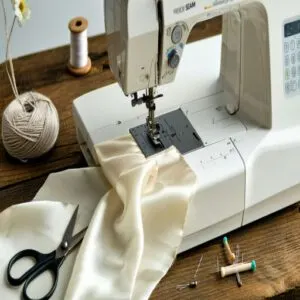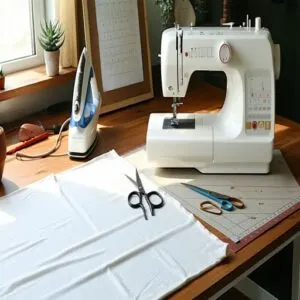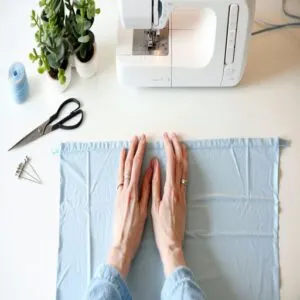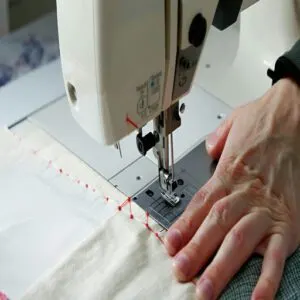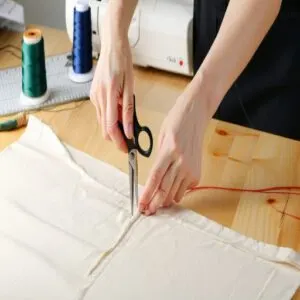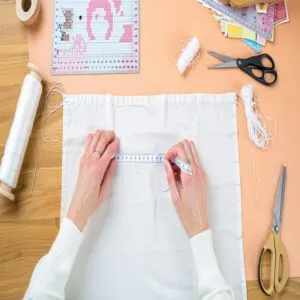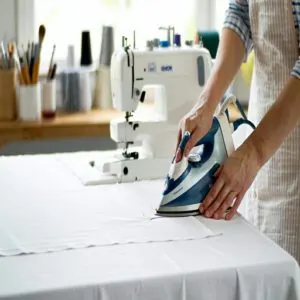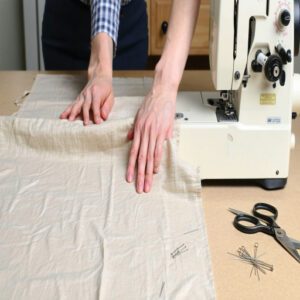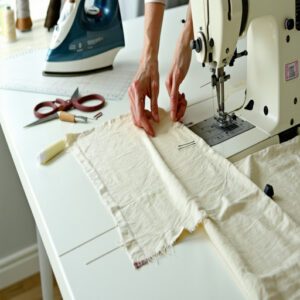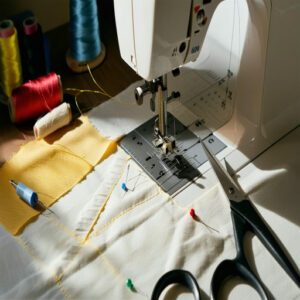This site is supported by our readers. We may earn a commission, at no cost to you, if you purchase through links.
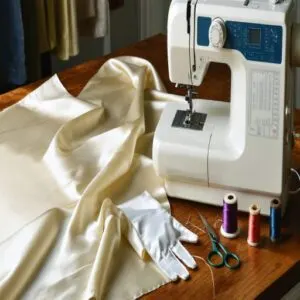
Sew a straight stitch about 1/4 inch from the edge, then trim the seam allowance neatly.
Next, press the seam flat, fold the fabric so the right sides are together, and sew again with a 3/8-inch seam allowance, encasing the raw edges inside.
Voilà! You’ve got a strong, professional finish perfect for lightweight fabrics like silk or voile.
French seams work wonders on garments or baby clothes, but avoid bulky fabrics.
Ready to tackle curves? That’s a whole other skill!
Table Of Contents
Key Takeaways
- Start with wrong sides together, sew a 1/4-inch seam, trim to 1/8 inch, press flat, then fold right sides together and sew again to enclose raw edges.
- Use lightweight fabrics like silk or voile and avoid bulky materials to ensure clean, professional finishes.
- Always press seams at each step—first flat, then after folding—to achieve sharp, polished results.
- Plan for at least 5/8-inch seam allowance (1/4 inch for the first stitch, 3/8 inch for the second) to successfully encase raw edges.
French Seam Basics
A French seam hides raw fabric edges by encasing them within a clean, double-stitched finish.
It’s perfect for lightweight fabrics like silk or cotton and gives your projects a durable, professional touch.
Definition of a French Seam
If you’ve ever wondered, “What is a French seam?” it’s a sewing technique that hides raw fabric edges for a clean, polished finish.
Instead of starting with right sides together, you sew with wrong sides together—a clever twist in seam construction.
This technique shines with lightweight or sheer fabrics, ensuring both garment durability and a professional seam finish.
By encasing raw edges, French seams add elegance and precision to any project, making them a key player in advanced sewing techniques.
Benefits of Using a French Seam
French seams are your go-to for both strength and elegance, giving garments a polished, professional finish inside and out.
They’re perfect for frequent washing or delicate fabrics prone to fraying.
Here’s why sewists swear by them:
- Seam Durability – Lock raw edges for long-lasting wear.
- Garment Longevity – No fraying means extended use.
- Sewing Efficiency – Skip the serger entirely!
Suitable Fabrics for French Seams
When picking fabric types for French seam sewing, stick to lightweight fabrics like silk, chiffon, or cotton voile.
These fabric textures and weave patterns are easy to handle and create smooth, enclosed finishes.
Avoid bulky materials since seam allowance builds up quickly and can get unwieldy.
Need extra finesse? A good press with starch works wonders on fabrics prone to fraying!
Understanding french seam basics is essential for achieving professional results in sewing projects.
Ideal Projects for French Seams
Looking to add finesse to your sewing projects? French seam sewing is perfect for items that need both beauty and durability.
Try these projects:
- Linen garments: For long-lasting, fray-free finishes.
- Silk dresses: Ideal for achieving a polished, high-fashion look.
- Baby clothes: Gentle on delicate skin.
- Curtain making: Flawless seams for sheer or lightweight fabrics.
- Home textiles: Think chic napkins or pillowcases.
Master this technique effortlessly!
Preparing for a French Seam
Before starting your French seam, gather your tools like pins, scissors, and an iron, and choose a thread color that blends with your fabric.
Prepare your sewing machine with the right settings for your fabric type to guarantee smooth, precise stitching.
Choosing The Right Thread Color and Type
A good thread color makes all the difference in French seam sewing.
Match your thread to the fabric for that polished look—use color theory to choose shades that blend or complement.
Thread weight is key; lightweight fabric calls for fine sewing threads.
Avoid thick yarn selection, which can strain thread tension and ruin your clean finish.
For a wide array of options, explore various sewing thread colors.
Adjusting Your Sewing Machine Settings
Dialing in your sewing machine settings is like tuning a guitar—it sets the stage for a flawless French seam.
Keep the stitch length at 2.5 mm for smooth, strong seams.
Balance tension control to prevent puckering; your threads should glide, not clash.
For specific tension adjustments, explore these sewing machine tension products.
Use a size 70/10 needle for lightweight fabrics.
Machine calibration complete? Hit the pedal confidently with a smooth, strong seam!
Pressing and Ironing Techniques for French Seams
Pressing is the secret to flawless French seams.
Set up your ironing board and adjust your iron temperature to match your fabric—steam works wonders for smoothing relaxed fabrics, but delicate ones prefer a dry iron.
When dealing with seam allowances, grab pressing tools like a clapper or a pressing cloth for extra precision.
Test your settings on scrap fabric first to avoid surprises.
Press each seam carefully after stitching to lock in that clean, polished look.
Remember, proper fabric smoothing and ironing make your seams truly shine!
Essential Tools for Sewing a French Seam
To nail a French seam, you’ll need a few essentials:
- Sewing machines: Straight stitch is all you need.
- Fabric cutters or sharp scissors: Precise trims matter.
- Pins: Keep layers steady.
- Iron and ironing boards: Flawless seams require pressing.
- Thread types and sewing needles: Match your fabric perfectly.
Having a well-stocked sewing kit essentials will make the process smoother.
These tools guarantee clean, professional seams every time.
Sewing The First Seam
Start by placing the fabric wrong sides together, which might feel backward, but it’s key to a perfect French seam.
Pin along the edge to keep the layers aligned, ensuring a smooth and precise first stitch.
Placing Wrong Sides Together
Start by placing the wrong sides of your fabric together.
It feels counterintuitive, but trust the process—this step is Seam Preparation 101!
Watch for fabric slippage and focus on precise Fabric Alignment for smooth results.
For better Edge Control, here’s a quick guide:
| Tip |
|---|
| Alignment |
To confirm is to make certain or verify, for better Edge Control, verify that all edges are properly matched before proceeding with the next steps.
Pinning and Sewing The First Seam
When sewing French seams, carefully align edges with precision.
Keep fabric tension steady and pin perpendicular to the seam for easy removal.
Maintain edge control by sewing with a consistent seam allowance.
- Pin placement: Space pins evenly to avoid slipping.
- Seam alignment: Match edges perfectly for a clean finish.
- Stitch length: Use small stitches for durability.
- Fabric tension: Stay consistent to prevent puckering.
Trimming The Seam Allowance
Once the first seam is stitched, grab your scissors or trimming tools and cut the seam allowance down to 1/8”.
This step keeps bulk at bay and guarantees your french seams appear sleek and professional.
Use sharp scissors for accurate fabric cutting to avoid jagged edges.
Clean seam trimming tips? Take your time—rushing can lead to uneven seam finishing, consider using sharp scissors.
Maintaining a Consistent Seam Allowance
Keeping a consistent seam allowance is the backbone of flawless French seams.
Use the seam guide on your machine or tools like a 1/4-inch presser foot for seam guidance. For precise seam width control, cut fabric edges cleanly and align them carefully.
Mastering basic hand sewing techniques is also essential for achieving a smooth, even seam.
Adjust stitch length for your fabric thickness—short stitches for delicate fabrics, longer for sturdier ones. Stay steady, and you’ll master this key step in professional seam finishing.
Creating The French Seam Enclosure
Now it’s time to enclose those raw edges and create a seamless finish.
You’ll fold the fabric so the right sides are together, iron it flat.
Sew a second line that completely hides the frayed edges.
Ironing The Seam Flat
After trimming your seam, grab your iron—it’s time to make things smooth.
Seam ironing tips? Use a pressing cloth to protect delicate fabrics and set the iron temperature appropriately for your material.
Press the seam flat without dragging, letting the heat lock in a neater look.
This step guarantees your french seam has a flawless, seam-finish base.
Folding The Fabric Right Sides Together
Once the seam is ironed flat, flip the fabric so the right sides face each other.
Smooth it out gently—precision is key here, use these fabric folding tips to guarantee perfect alignment.
Uneven edges throw off your sewing, and double-check your folding techniques because clean seam sewing makes french seams stand out, especially in delicate fabric sewing or high-fashion projects.
Ironing The Folded Seam
Once you’ve folded the fabric right sides together, it’s time to grab your iron.
Use medium heat to gently press along the folded edge. This step guarantees smooth fabric preparation and precise folded edge control.
Keep the iron moving to avoid heat spots.
Proper seam ironing tips like this guarantee a clean finish for your french seam.
Pinning and Sewing The Second Seam
Pin placement is key here—align the folded fabric edges carefully for perfect seam alignment.
Keep fabric tension smooth as you stitch, using a consistent 1/4" seam allowance.
Adjust the stitch length slightly for thin fabrics, ensuring strong edge finishing.
This step, essential in sewing techniques, enhances how to make french seams, even mimicking seams seen in high fashion.
Finishing The French Seam
You’re almost done!
Now, remove any pins, trim stray threads, and press the seam to one side for a polished finish.
These final touches guarantee your French seam looks clean and professional, ready to withstand wear and washing.
Removing Pins and Trimming Threads
Say goodbye to those pins—gently remove them to avoid any “ouch” moments.
Now, grab your favorite thread trimming tools and clean up those stray ends.
Keep things neat by:
- Using sharp scissors or snips for crisp cuts.
- Double-checking seam allowance management for accuracy.
- Tossing threads into a bin (not the floor).
- Handling fabric edges gently.
- Following trimming safety tips for perfect results.
Pressing The Seam to One Side
With your fabric freshly sewn, grab that iron—set to the right temperature for your material—and press the seam to one side.
This step smooths wrinkles and locks the seam allowance neatly, ensuring a polished seam finish.
Use firm, steady motions for even results.
Proper pressing techniques are essential, turning ordinary sewing instructions into professional-looking steps of making conspicuous seams.
Tips for a Professional Finish
For professional-looking seams, remember these sewing tips:
- Seam Finishing: Always press seams flat before folding, ensuring a crisp foundation.
- Edge Trimming: Trim seam allowances neatly to avoid bulk.
- Fabric Selection: Stick to lightweight fabrics for smoother results.
- Sewing Accuracy: Keep stitch lines straight for a polished seam finish.
Patience and precision create truly professionallooking seams!
Avoiding Common Mistakes
Avoiding common mistakes with a French seam starts with consistent seam allowance.
Uneven stitches? Double-check your pinning.
Fabric bunching is a press-it-flat reminder—don’t skip ironing each step!
Tension problems or thread breakage? Adjust your sewing machine settings before starting.
For smooth results, align fabric edges carefully and keep a steady hand—you’ll sidestep conspicuous seams in no time with proper sewing machine settings.
Troubleshooting French Seams
Sometimes, French seams don’t go as smoothly as planned, especially with bulky fabrics or tricky curves.
Don’t worry—you can fix common issues with a few adjustments and finish your project with confidence.
This will allow you to complete your project successfully.
Dealing With Bulkiness in Thick Fabrics
Thick fabrics and French seams don’t always get along, but you can smooth things out with a few tricks.
Fabric layering is essential—trim excess bulk and press seams perfectly flat, which is crucial for clean results.
Consider swapping for seam finish options, like a flat-felled or overlocked seam, to keep things neat.
For lightweight and sheer fabrics, French seams create a clean finish.
When bulk management is key, a wider seam allowance helps, and always press firmly and consistently for clean results on thick fabric projects.
Managing Curved Seams and Stretchy Fabrics
Curved seams or stretchy fabrics can test your patience, but with the right sewing techniques, you’ll simplify the process.
- Use basting stitches to control seam curvature during french seam projects.
- A stretch stitch helps manage fabric stretch effectively.
- Trim allowances to reduce bulk.
- Master pressing techniques for flawless curves.
Consistency and practice are key to taming sewing challenges!
Solving Issues With Knit Fabrics
Working with knit fabrics can be tricky, but it’s manageable with the right sewing techniques.
Use a ballpoint needle and polyester thread for smooth stitching, and stabilize seams with stretchy seam solutions like stay tape.
Avoid pulling fabric to maintain tension and alignment, and minimize bulk by opting for narrow seam allowances.
This approach is essential for clean, professional-looking French seams in stretchy fabric projects.
Overcoming Time-Consuming Challenges
Efficient time management turns sewing French seams into a breeze.
Batch similar sections, like sleeves, for fabric efficiency, use precise pinning to stay aligned without overthinking.
Press seams faster with finger pressing as a shortcut, follow seam allowance tips to avoid mishaps and uneven lines.
Master these productivity tips for flawless seams in less time, essential for high-fashion-worthy results!
Mastering French Seam Variations
You can elevate your sewing projects by exploring French seam variations suited for different fabrics and styles.
From delicate garments to bold topstitching, these techniques let you add strength, elegance, and creativity to your work.
Adapting French Seams for Delicate Fabrics
Working with delicate fabrics like silK or chiffon takes finesse, but you’ve got this.
Narrow your seam allowance to around 1/4 inch to prevent bulk.
Use shorter stitches and keep your thread tension settings balanced to avoid puckering.
For ideal results, consider stabilizing delicate fabrics to prevent slippage and stretching.
For the best delicate seam finishes, use these tips:
- Choose lightweight fabrics from the Fabric Choice Guide.
- Press gently between stitching for smooth edges.
- Match thread colors for an invisible finish.
- Practice Seam Allowance Control on scraps first.
Using French Seams in Home Decor Projects
Using French seams in home decor elevates sewing projects like cushions, curtains, and tablecloths.
This technique hides raw edges and adds durability and sophistication to home textiles.
Lightweight fabrics pair beautifully, while precise seam allowance guarantees neatness.
For inspiration, explore various French seam home decor products.
For added flair, try decorative stitches.
Curtain making or any fabric project becomes polished and professional with proper sewing techniques, which also makes them more durable and refines their appearance.
Creating French Seams in Garments and Accessories
Creating French seams in garments and accessories steps up your sewing basics.
Think lightweight fabrics, sharp seams, and zero raw edges.
Precision matters — calculate seam allowances, press between steps, and avoid bulk on curves.
Whether it’s garment construction or accessory making, patience wins every time.
- Smooth edges = sleek looks that last
- Light fabrics = perfect French seam partners
- Practice = pro-level finish
Experimenting With Colored Threads and Topstitching
When it’s time to elevate your french seam game, topstitching techniques combined with creative thread color options can work wonders.
Using vibrant colored threads creates bold, eye-catching seam effects, while softer hues deliver a sleek, professional elegance.
For a pristine finish, learn how to sew a French seam to enclose raw edges.
Want to go bold? Try decorative stitches for unique patterns. Align your presser foot with the seam edge for smoother stitching.
With the right sewing threads, visible threads can transform simple seams into striking design elements.
Frequently Asked Questions (FAQs)
How do you do a French seam step by step?
Imagine taming unruly edges like a craft ninja: sew wrong sides together, trim to 1/8".
Press.
Fold right sides together, stitch encasing raw edges.
Press again.
Your seams now? Sleek, durable, and totally masterpiece-worthy!
What is the difference between a French and felled seam?
A French seam hides raw edges inside the seam, creating a clean finish.
While a felled seam overlaps edges and stitches them down for durability, think flawless inside for French, rugged strength for felled.
When should you not use a French seam?
You shouldn’t use a French seam on thick fabrics—they’ll get bulky and awkward.
Skip it for curved seams or stretchy fabrics, as they don’t hold well.
Tight deadlines? Opt for faster finishing techniques instead.
What is the difference between a French seam and a regular seam?
A regular seam leaves raw edges exposed, prone to fraying.
A French seam locks those edges inside a double-stitched fold, creating a polished, clean finish.
It’s like wrapping up your edges in a tidy package!
Can I sew a French seam?
You’ll be glad to know that French seams are simple to learn.
With basic sewing skills, matching thread, and the right fabric weight, you can master this elegant technique in just a few practice runs.
What is the difference between a French seam and an ordinary seam?
You’ll find two key differences: An ordinary seam shows raw edges inside your garment, while a French seam hides them by encasing them within a double fold.
It’s neater and more durable.
How do you stitch a French seam on a sewing machine?
Place wrong sides together, stitch at 1/4 inch, trim seam to 1/8 inch, and press. Then fold right sides together, press again, and stitch at 1/4 inch to encase raw edges.
How do you sew a French seam on a curve?
Make tiny snips along the curved edge before your first stitch. Then, with wrong sides together, stitch slowly at 1/4". Trim, press, and fold right sides together. Finally, stitch 3/8" to enclose.
What is the difference between a French seam and a flat felled seam?
Cut to the chase: A French seam hides raw edges inside, creating a clean interior finish.
While a flat felled seam shows on both sides with two rows of visible stitching, like on jeans.
Do you need extra seam allowance for French seams?
Yes, you’ll need extra allowance for French seams.
Plan for at least 5/8 inch total – 1/4 inch for the first seam and 3/8 inch for the second.
This guarantees your raw edges stay neatly enclosed.
Conclusion
Mastering how to sew a French seam might feel like conquering Mount Everest at first glance, but it’s simpler than it looks.
By carefully placing wrong sides together, sewing, trimming, folding, and pressing, you’ll create strong, polished seams that elevate your projects.
Whether you’re working with delicate silk or crafting baby clothes, this technique guarantees clean, professional results, and with practice, it’ll become second nature.
You’ll never dread raw edges again, and with this skill, you’ll be ready to get started.
- https://sewingtrip.com/how-to-sew-a-french-seam/
- https://oliverands.com/community/blog/2010/04/french-seams.html
- https://sewing.patternreview.com/SewingDiscussions/topic/62781
- https://www.moodfabrics.com/blog/all-about-sewing-seams/
- https://www.thehogring.com/2012/02/24/get-bolder-french-seams-with-qtc-contrast/

